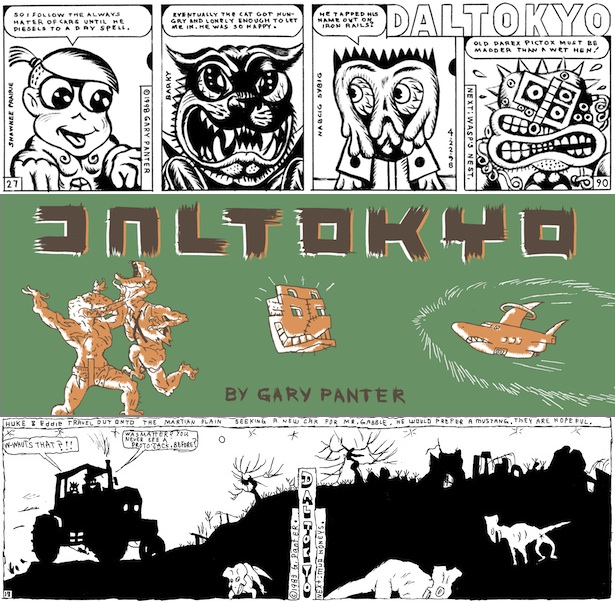Gary Panter the Future of Art 25 Years Hence
The acclaimed artist's early-'80s, post-apocalyptic drawings return in a new compilation book.

Dal Tokyo, the cool, punk, sci-fi, postmodern, mail service-apocalypse comic strip that began in 1983 and is fix in a "hereafter Mars that is 'terraformed' by Texan and Japanese workers" was artist Gary Panter's earliest opus. Panter's ratty line was the gold standard of postal service-underground comics, but this emblematic series of strips was all simply lost until Fantagraphics recently published the first collection of them in an actress-narrow, horizontal gem of a volume featuring his false Japanese lettering on the encompass.
Panter, who went on to design the sets for Pee Wee's Playhouse and publish graphic novels based on Dante's rings of hell featuring his famous Jimbo character as protaganist, recently talked to me almost the genesis of his resurrected first born.
At the time of Dal Tokyo'south conception, Panter was influenced past A Clockwork Orangish—both Anthony Burgess's novel and Stanley Kubrick'due south picture show—as well as a poem by a high school friend, Max Watson, most a fourth dimension rupture that causes all times and cultures to coexist in their home town of Sulphur Springs, Texas. "Max's idea was the seed for a confluent-culture project," says Panter, who says he was inspired past Watson's "love of dinosaurs and oddball cultural stuff" from his childhood, like cargo cults and monster movies.
He also became enamored with the work of Philip K. Dick while in college, admiring the writer's "virtually-future arroyo to science fiction." In fact, Panter became friends with Dick and before his death used to visit him in Orange County. I asked Panter whether Blade Runner was a prime number influence. "About the time the Bract Runner pic was coming out, I was told that some of my fake Japanese style lettering was on the wall of the Bract Runner design office," he says. "So I may have had i ounce of influence on Blade Runner's look."
MORE ON Fine art AND DESIGN



But Dal Tokyo goes dorsum further in time to when, afterwards graduating art school, Panter, the kid of Texan "holy rollers," was working as a janitor in a Dallas insurance company. It was and so that the visual and verbal ideas started flowing. Only it took years before he could get them out anywhere. "In my listen, my comic characters lived there and I had envisioned a society, merely it wasn't coming out fast enough in my other comics to exist visible," he says. "So when there was the prospect of doing a comic for the LA Reader, every calendar week, information technology seemed like the projection already had the virtually textile in it and wanted out of my brain."
"I did the weekly for a year (1983-84) and information technology was difficult, because even though it looks scratchy, it was aggressive and took a long time to draw," he says. "My pilus vicious out after a twelvemonth from various stresses was under, and then I stopped making it and the editor didn't similar information technology anyhow, because it was strange and not commercial, so we agreed for me to terminate the strip." Years later, Panter's agent in Nihon, Shizuo Ishii, asked him to depict it for a reggae mag monthly, RIDDIM. "He gave me complete liberty with information technology, so as a monthly and with freedom I couldn't say no," he says. "Plus, having information technology appear in Japan only in a reggae magazine seemed like the ultimate place for it."
Panter had visited Japan at least once earlier starting the comic, only had also studied Japanese culture since college, with his interest in Godzilla movies and woodblock prints leading him to read up on Kabuki, Bunraku, and Noh theater.
The characters in Dal Tokyo, notably the golem-similar Jimbo, emerged from his studies. "I started characters and tried to get down what they were doing and tried to remember all the balls that were in play," he says. "Once several characters were in play, and I allow more and more and more characters be in play to get across the idea of the city and the landscape."
The strip was reborn from 1996 to 2007 and remains the wellspring of Panter'south comic globe. But it as well changed from the outset iteration to the second. "One thing that caused the strip to change, visually, is that I decided to use dip nibs from Nihon, when I started drawing it once more for RIDDIM, as opposed to the rapidographs that I started cartoon the story with originally and dip nibs tend to brand my drawing look one-time fashioned," he says. Also: "I kept all my story threads in heed and extended them, but focused more than on a metafictional type of 2nd life for the strip." Many of his paintings and prints take been adult around the Dal Tokyo comic panels. So having this volume is a guide to Panter's current work, which seeks to transcend comics for something richer. Or as he says, "I am a painter and a fan of what happened to painting in the 20th century, and I tend to bring those ideas with me to comics."
Dal Tokyo might all-time exist seen as a combination of nightmare, daydream, ramble, and sketch, with a decided stream-of-consciousness tone, which is not different Panter'south own Texas lilting manner when talking. In fact, for all its eccentricity, Dal Tokyo is akin to a Texas alpine tale. Panter might not concord.
"Making Dal Tokyo was for me kind of like dousing for water - a kind of magical sensitivity session," he says. "And a sandbox with toys I invented, featuring fragments of stories that a kid would tell you about the toys. I am perpetually curious about where humanity is going and what daily life might be similar in the far and near futurity afterward I am composted, as well every bit being preoccupied with visualizing possible lost pasts of humanity from Lascaux until early Turkish monuments we don't know much about." He adds, though, that there'south a foreign optimism to his vision of the future: "Humanity volition go along and on and slowly surpass the apes." Apocalyptic or non, that's a happy idea.
Source: https://www.theatlantic.com/entertainment/archive/2012/10/when-dallas-met-tokyo-met-mars-gary-panters-lost-dal-tokyo-comic/263793/
0 Response to "Gary Panter the Future of Art 25 Years Hence"
Post a Comment